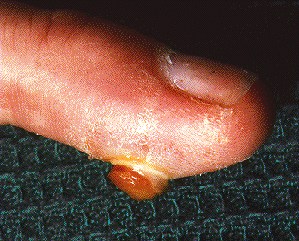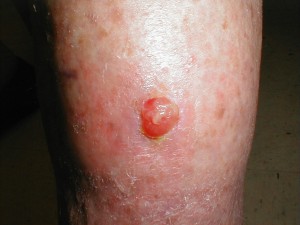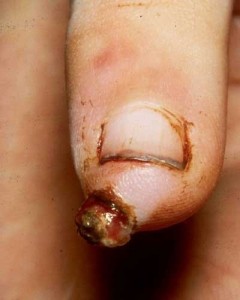Pyogenic granuloma has been said to account for anywhere from 26.8-32% of all reactive lesions on the human body. Read and know what is Pyogenic granuloma. You may also get complete information about the causes, symptoms, diagnosis and treatment of this skin disorder.
Pyogenic granuloma Definition
Page Contents
- 1 Pyogenic granuloma Definition
- 2 Pyogenic granuloma ICD-9 Code
- 3 Oral Pyogenic granuloma
- 4 Who Gets Pyogenic granuloma?
- 5 Pyogenic granuloma Symptoms
- 6 Pyogenic granuloma in Children
- 7 Pyogenic granuloma Causes
- 8 Pyogenic granuloma Diagnosis
- 9 Pyogenic granuloma Differential Diagnosis
- 10 Pyogenic granuloma Treatment
- 11 Pyogenic granuloma Medicines
- 12 Pyogenic granuloma Home Remedies
- 13 Pyogenic granuloma Prognosis
- 14 Pyogenic granuloma Complications
- 15 Pyogenic granuloma Prevention
- 16 Pyogenic granuloma Pictures
It is a type of non-cancerous (benign) skin condition characterized by the development of tiny red growths on the skin surface. It is mainly considered as an oral disorder.

Picture 1 – Pyogenic granuloma
The condition is also known as Lobular Capillary Hemangioma. It is common in children.
Pyogenic granuloma ICD-9 Code
The ICD-9 Code for Pyogenic granuloma (PG) is 686.1.
Oral Pyogenic granuloma
It is a type of Pyogenic granuloma that affects the oral region or mouth. The condition gives rise to purple or red colored growths on the oral region. The growths may be smooth or lobulated and can range anywhere from 1 mm to a few centimeters in size. As these arise on the mouth, which is continuously exposed to irritation and movement, they cause pain to sufferers. The lesions grow quickly and discharge much blood, even without any injury. The granulomas comprise of many blood vessels, which gives them a reddish appearance.
Who Gets Pyogenic granuloma?
The condition primarily affects kids and adolescents as well as young adults. Even though it is common in many males, medical research suggests that the disease affects females more. The disorder is usually observed in pregnant women during the first trimester and persists until the seventh month of maternity. The growths are either seen around the mouth or in the anterior nasal septum. In both males and females, the disease manifests on the maxillary jaw and the gingiva. The lesions also arise on the lips, the tongue and the inner side of the cheek. Poor oral hygiene is found to aggravate the syndrome.
Pyogenic granuloma Symptoms
As aforesaid, the skin condition is characterized by the formation of growths on the human body. These are small, red lumps caused by an overgrowth of tissue. The lesions arise on various regions of the body, such as eyelids, face, tongue, lip, arms, hands and feet.
Pyogenic granuloma on Eyelid
The condition gives rise to reddish-pink vascular bumps over the eyelid and is said to be caused due to a rich supply of blood from the conjunctiva. The growths may also arise if there is a rupture (tear) of a chalazion. A chalazion refers to a lesion that arises on an eyelid due to the swelling of a sebaceous gland or a hair follicle on the eyelid.
Pyogenic granuloma on Tongue
These growths characteristically arise on the lateral side of the tongue. The cause of development of the lesions on the tongue is unclear, though they are supposed to originate due to trauma from dentures or adjacent teeth.
Pyogenic granuloma on Lip
PG lesions usually arise as solitary growths on the lip. The growths generally develop on the lower lip though they may also arise on the upper lip in rare cases. Upper lip is an abnormal location for the development of these bumps.
Pyogenic granuloma on Fingers
These growths are also common on hands and fingers. When arising on fingers, these lesions are found to be solitary in nature and look like reddish blisters. The bumps commonly arise after a minor injury at the site of their formation.
Pyogenic granuloma on Face
The lesions are also common on the facial region. PG growths arising on the face are generally multiple in number and look like small red or reddish-purple lumps. These are filled with many blood capillaries and commonly develop after a trauma. The lumps can bleed easily.
Pyogenic granuloma on Feet
It is the most common type of cutaneous vascular lesion arising on the foot. The bumps commonly arise in the nail fold of a toe with an accompanying ingrown toenail.
Blisters caused by PG also arise on other regions of the body, but with a lesser frequency. The growths are found to be most common in the region around the mouth followed by other areas like the arms, hands and face. These are frequently seen to arise in the mouths of women who are in the initial stages of pregnancy.
These blisters are extremely vascularized. In other words, they contain a high amount of blood vessels which indicates why the growths discharge a high amount of blood on rupturing. The lumps also weep (or ooze fluids) from time to time and look like pieces of raw meat.
Pyogenic granuloma in Children
These skin growths are common in grown-up children but rare in kids less than 6 months of age. Even though the condition is more common in females than males, it affects boy and girl children equally. The growths are not cancerous, but tend to bleed if children accidentally rupture them. These are generally removed by minor surgery. If the process fails to improve the problem, Cauterization may be required. In young children, a general anesthetic may be required prior to ablation. In most cases, clinical outcome is found to be satisfactory. However, removal may cause complications like dyspigmentation and scarring.
It is essential for doctors to destroy the entire lesion, as there may be a possibility of recurrence if fragments of the bump are left intact in the skin.
Pyogenic granuloma Causes
The exact reason for the appearance of this disease is unknown. However, some of the possible causes of Pyogenic granuloma are regarded to be:
Skin trauma
The growths are generally supposed to be a result of trauma (injury). People suffering from PG lesions usually notice them after suffering an injury.
Medicinal side effects
The lesions are also found to develop in people using certain medications, particularly those used to treat acne problems. The condition is also found to arise on use of drugs like Accutane, Soriatane, Indinavir and oral contraceptives. Development of benign overgrowths of tissue may occur due to side effects of these medications.
During diagnosis of such skin conditions, it is essential for patients to hand over to their doctors a list of currently used medications. They should also inform physicians whether they have a history of skin conditions.
Pyogenic granuloma Diagnosis
The lesions may initially be mistaken for scabs or poorly healed patches of skin. However, a simple physical examination of the unusual growths is enough for experienced physicians to diagnose this syndrome. In some cases, a skin biopsy may be required to confirm the diagnosis.
Once a Pyogenic Granuloma is diagnosed, doctors usually recommend a removal of the growth. This helps relieve pain and any other discomfort that may be caused due to recurrent bleeding. Removal also allows physicians send the overgrown mass of tissue for biopsy and confirm whether it is a Pyogenic granuloma or any cancerous outgrowth. Cancerous lumps can often have a superficial appearance similar to these growths. Due to this reason, it is necessary for doctors to take precautions as early as possible.
Pyogenic granuloma Differential Diagnosis
The differential diagnosis for Pyogenic granuloma involves ruling out presence of other condition that might produce similar symptoms, such as
- Bacillary angiomatosis
- Epithelioid hemangioma
- Hyperplastic gingival inflammation
- Kaposi’s sarcoma
- Peripheral fibroma
- Peripheral giant cell granuloma
Pyogenic granuloma Treatment
These growths are harmless but can cause irritation or pain. Treatment is necessary for this reason. Sometimes, doctors may suspect the lesions to be symptoms of an underlying cancerous condition. In such cases, removal of the growths becomes necessary. Removal can be accomplished by a minor surgery that may quickly be performed as an outpatient procedure in a clinic or a doctor’s office. Small growths resolve suddenly without any need of removal. Larger bumps may be treated with
- Surgery
- Electrocautery
- Freezing
- Laser Therapy
Techniques such as Cauterization may, however, lead to a recurrence of the lesions. Removal of the overgrowth itself as well as its margins with a scalpel can lower the risk of recurrence.
In pregnant women, this condition usually dries up and resolves on its own. Treatment is not used in the case of pregnancy. Recurrent bleeding can, however, make it necessary to cauterize or excise (surgical ablation) the lesion.
The treatment of PG lesions often depend on the region of their formation. Treatment for Pyogenic Granuloma growths on two primary body regions are discussed below:
Treatment of Oral Pyogenic Granuloma
Oral lesions of this type can effectively be treated with the aid of:
- Dental care
- Dental cleaning
- Removal of calculus or any other source of irritation
- Conservative surgery
Treatment of Pyogenic granuloma on Eyelid
A PG lesion arising on the eyelid, particularly due to a Chalazion, should be treated at the earliest. A biopsy of a sample of the lesion can help doctors distinguish it from a cancerous skin condition called Amelonatic Melanoma. If no cancer is detected, doctors may prescribe steroids, lubricants or some medicated eye drops to relieve any irritation. Smaller lesions may resolve with drugs. Larger growths require curettage followed by cauterization under the effects of general anesthesia.
Pyogenic granuloma Medicines
Medications are typically used to cure the discomforting symptoms caused by Pyogenic granuloma, such as pain and irritation. If patients are found to suffer from minor pain, doctors may recommend nonprescription drugs such as aspirin or acetaminophen. If the scab oozes or cracks, a nonprescription antibiotic ointment must be applied for several times a day. Medicines are also found to stop and eliminate other problems, such as oozing, bleeding, foul odor and sequent necrosis.
Pyogenic granuloma Home Remedies
Since time immemorial, certain home remedies have been trusted for natural treatment of discomforting skin problems such as Pyogenic granuloma. You may try these remedies at home:
Garlic
Slice a clove of garlic into two halves. Place one slice over the lesion and attach it with a cloth bandage. Leave the clove undisturbed overnight. Repeat the remedy for another two to three days or until you seen an improvement.
Flaxseed mixture
Add a few flaxseeds into flaxseed oil. Pour 1-2 tsp raw honey into the mixture and combine well. Apply this mixture over the lesion and gently rub it in. Repeat the process for a few more days until you find the lesions fading away.
Apple Cider Vinegar
Soak a small piece of cloth into warm water and place on the growths for 15-20 minutes. Air-dry the area. Next, soak a cotton ball into apple cider vinegar and leave it on the blisters for another 10-15 minutes before washing. Continue the therapy for several days to remove the lesions naturally.
Pyogenic granuloma Prognosis
Most pyogenic granulomas can be removed, but scarring may appear after treatment. There is a good chance that the condition will return if the entire granuloma is not destroyed during treatment. Good. Recurrence is infrequently seen.
Pyogenic granuloma Complications
This being a benign growth, there is no risk of cancerous complications. However, there may be other discomforts like bleeding from the lesion which may cause pain and tenderness in the region. Even when treated, the skin ulcers may recur in some cases and reappear in an entirely different location. Sometimes these growths can also spread through the bloodstream.
Pyogenic granuloma Prevention
The prevention of this condition is difficult, as its cause is not known. Avoiding trauma (injury) may reduce the risk. However, it is not always possible to avoid injuries. Those suffering from nasal lesions should be discouraged from picking nose, as it might aggravate the growths.
Pyogenic granuloma Pictures
Here are some useful Pyogenic granuloma photos that will give you an idea about the appearance of the lesions caused by this condition. Check out these Pyogenic granuloma images to get a reference.

Picture 2 – Pyogenic granuloma Image

Picture 3 – Pyogenic granuloma Photo
If you have skin lesions that bleed easily or change in appearance, immediately get in touch with an experienced health care provider. Timely diagnosis and treatment of the condition can help you make a faster recovery from the syndrome and get relief from any discomforting symptoms that you may be suffering from. Early treatment will also help you avoid any underlying cancerous conditions that you have been mistaking for Pyogenic granuloma.
References:
http://www.pennmedicine.org/encyclopedia/em_displayArticle.aspx?gcid=001464&ptid=1
http://dermnetnz.org/vascular/pyogenic-granuloma.html
http://www.drugs.com/enc/pyogenic-granuloma.html
http://emedicine.medscape.com/article/763200-overview

I had a LARGE pyogenic granuloma on the ball of my foot. I treated it with apple cider vinegar twice sometimes 3 times a day. Within 2.5 weeks it dropped off. Had biopsy done and was benign. Worked for me